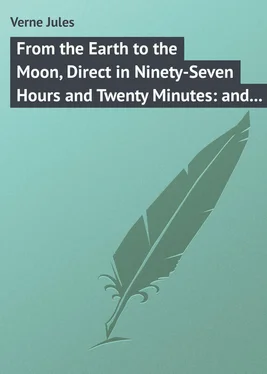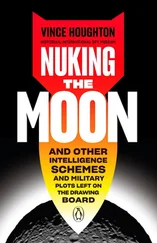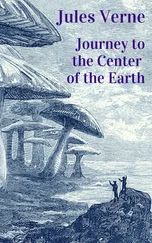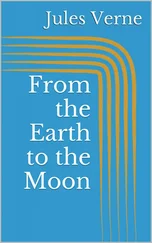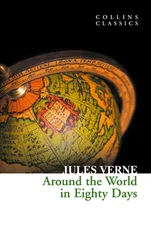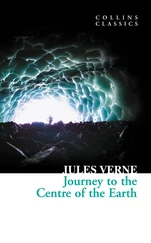Jules Verne - From the Earth to the Moon, Direct in Ninety-Seven Hours and Twenty Minutes - and a Trip Round It
Здесь есть возможность читать онлайн «Jules Verne - From the Earth to the Moon, Direct in Ninety-Seven Hours and Twenty Minutes - and a Trip Round It» — ознакомительный отрывок электронной книги совершенно бесплатно, а после прочтения отрывка купить полную версию. В некоторых случаях можно слушать аудио, скачать через торрент в формате fb2 и присутствует краткое содержание. Жанр: foreign_prose, на английском языке. Описание произведения, (предисловие) а так же отзывы посетителей доступны на портале библиотеки ЛибКат.
- Название:From the Earth to the Moon, Direct in Ninety-Seven Hours and Twenty Minutes: and a Trip Round It
- Автор:
- Жанр:
- Год:неизвестен
- ISBN:нет данных
- Рейтинг книги:5 / 5. Голосов: 1
-
Избранное:Добавить в избранное
- Отзывы:
-
Ваша оценка:
- 100
- 1
- 2
- 3
- 4
- 5
From the Earth to the Moon, Direct in Ninety-Seven Hours and Twenty Minutes: and a Trip Round It: краткое содержание, описание и аннотация
Предлагаем к чтению аннотацию, описание, краткое содержание или предисловие (зависит от того, что написал сам автор книги «From the Earth to the Moon, Direct in Ninety-Seven Hours and Twenty Minutes: and a Trip Round It»). Если вы не нашли необходимую информацию о книге — напишите в комментариях, мы постараемся отыскать её.
From the Earth to the Moon, Direct in Ninety-Seven Hours and Twenty Minutes: and a Trip Round It — читать онлайн ознакомительный отрывок
Ниже представлен текст книги, разбитый по страницам. Система сохранения места последней прочитанной страницы, позволяет с удобством читать онлайн бесплатно книгу «From the Earth to the Moon, Direct in Ninety-Seven Hours and Twenty Minutes: and a Trip Round It», без необходимости каждый раз заново искать на чём Вы остановились. Поставьте закладку, и сможете в любой момент перейти на страницу, на которой закончили чтение.
Интервал:
Закладка:
"The Staff of the Cambridge Observatory place themselves entirely at their disposal in respect of all questions of theoretical astronomy; and herewith add their congratulations to those of all the rest of America.
"For the Astronomical Staff,
"J. M. BELFAST,
" Director of the Observatory of Cambridge. "
CHAPTER V.
THE ROMANCE OF THE MOON
An observer endued with an infinite range of vision, and placed in that unknown centre around which the entire world revolves, might have beheld myriads of atoms filling all space during the chaotic epoch of the universe. Little by little, as ages went on, a change took place; a general law of attraction manifested itself, to which the hitherto errant atoms became obedient: these atoms combined together chemically according to their affinities, formed themselves into molecules, and composed those nebulous masses with which the depths of the heavens are strewed.
These masses became immediately endued with a rotary motion around their own central point. This centre, formed of indefinite molecules, began to revolve round its own axis during its gradual condensation; then, following the immutable laws of mechanics, in proportion as its bulk diminished by condensation, its rotary motion became accelerated, and these two effects continuing, the result was the formation of one principal star, the centre of the nebulous mass.
By attentively watching, the observer would then have perceived the other molecules of the mass, following the example of this central star, become likewise condensed by gradually accelerated rotation, and gravitating round it in the shape of innumerable stars. Thus was formed the Nebulæ, of which astronomers have reckoned up nearly 5000.
Amongst these 5000 nebulæ there is one which has received the name of the Milky Way, and which contains eighteen millions of stars, each of which has become the centre of a solar world.
If the observer had then specially directed his attention to one of the more humble and less brilliant of these stellar bodies, a star of the fourth class, that which is arrogantly called the Sun, all the phenomena to which the formation of the Universe is to be ascribed would have been successively fulfilled before his eyes. In fact, he would have perceived this sun, as yet in the gaseous state, and composed of moving molecules, revolving round its axis in order to accomplish its work of concentration. This motion, faithful to the laws of mechanics, would have been accelerated with the diminution of its volume; and a moment would have arrived when the centrifugal force would have overpowered the centripetal, which causes the molecules all to tend towards the centre.
Another phenomenon would now have passed before the observer's eye, and the molecules situated on the plane of the equator escaping, like a stone from a sling of which the cord had suddenly snapped, would have formed around the sun sundry concentric rings resembling that of Saturn. In their turn, again, these rings of cosmical matter, excited by a rotary motion round the central mass, would have been broken up and decomposed into secondary nebulosities, that is to say, into planets. Similarly he would have observed these planets throw off one or more rings each, which became the origin of the secondary bodies which we call satellites.
Thus, then, advancing from atom to molecule, from molecule to nebulous mass, from that to a principal star, from star to sun, from sun to planet, and hence to satellite, we have the whole series of transformations undergone by the heavenly bodies during the first days of the world.
Now, of those attendant bodies which the sun maintains in their elliptical orbits by the great law of gravitation, some few in their turn possess satellites. Uranus has eight, Saturn eight, Jupiter four, Neptune possibly three, and the Earth one. This last, one of the least important of the entire solar system, we call the Moon ; and it is she whom the daring genius of the Americans professed their intention of conquering.
The moon, by her comparative proximity, and the constantly varying appearances produced by her several phases, has always occupied a considerable share of the attention of the inhabitants of the earth.
From the time of Thales of Miletus, in the fifth century b. c., down to that of Copernicus in the fifteenth and Tycho Brahé in the sixteenth century a. d., observations have been from time to time carried on with more or less correctness, until in the present day the altitudes of the lunar mountains have been determined with exactitude. Galileo explained the phenomena of the lunar light produced during certain of her phases by the existence of mountains, to which he assigned a mean altitude of 27,000 feet. After him Hévelius, an astronomer of Dantzic, reduced the highest elevations to 15,000 feet; but the calculations of Riccioli brought them up again to 21,000 feet.
At the close of the eighteenth century Herschell, armed with a powerful telescope, considerably reduced the preceding measurements. He assigned a height of 11,400 feet to the maximum elevations, and reduced the mean of the different altitudes to little more than 2400 feet. But Herschell's calculations were in their turn corrected by the observations of Halley, Nasmyth, Bianchini, Gruithuysen, and others; but it was reserved for the labours of Bœer and Mædler finally to solve the question. They succeeded in measuring 1905 different elevations, of which six exceed 15,000 feet, and twenty-two exceed 14,400 feet. The highest summit of all towers to a height of 22,606 feet above the surface of the lunar disc. At the same period the examination of the moon was completed. She appeared completely riddled with craters, and her essentially volcanic character was apparent at each observation. By the absence of refraction in the rays of the planets occulted by her we conclude that she is absolutely devoid of an atmosphere. The absence of air entails the absence of water. It became, therefore, manifest that the Selenites, to support life under such conditions, must possess a special organization of their own, must differ remarkably from the inhabitants of the earth.
At length, thanks to modern art, instruments of still higher perfection searched the moon without intermission, not leaving a single point of her surface unexplored; and notwithstanding that her diameter measures 2150 miles, her surface equals the 1-15th part of that of our globe, and her bulk the 1-49th part of that of the terrestrial spheroid – not one of her secrets was able to escape the eyes of the astronomers; and these skilful men of science carried to even greater degree their prodigious observations.
Thus they remarked that, during full moon, the disc appeared scored in certain parts with white lines; and, during the phases, with black. On prosecuting the study of these with still greater precision, they succeeded in obtaining an exact account of the nature of these lines. They were long and narrow furrows sunk between parallel ridges, bordering generally upon the edges of the craters. Their length varied between ten and 100 miles, and their width was about 1600 yards. Astronomers called them chasms, but they could not get any farther. Whether these chasms were the dried-up beds of ancient rivers or not they were unable thoroughly to ascertain.
The Americans, amongst others, hoped one day or other to determine this geological question. They also undertook to examine the true nature of that system of parallel ramparts discovered on the moon's surface by Gruithuysen, a learned professor of Munich, who considered them to be "a system of fortifications thrown up by the Selenitic engineers." These two points, yet obscure, as well as others, no doubt, could not be definitively settled except by direct communication with the moon.
Читать дальшеИнтервал:
Закладка:
Похожие книги на «From the Earth to the Moon, Direct in Ninety-Seven Hours and Twenty Minutes: and a Trip Round It»
Представляем Вашему вниманию похожие книги на «From the Earth to the Moon, Direct in Ninety-Seven Hours and Twenty Minutes: and a Trip Round It» списком для выбора. Мы отобрали схожую по названию и смыслу литературу в надежде предоставить читателям больше вариантов отыскать новые, интересные, ещё непрочитанные произведения.
Обсуждение, отзывы о книге «From the Earth to the Moon, Direct in Ninety-Seven Hours and Twenty Minutes: and a Trip Round It» и просто собственные мнения читателей. Оставьте ваши комментарии, напишите, что Вы думаете о произведении, его смысле или главных героях. Укажите что конкретно понравилось, а что нет, и почему Вы так считаете.
